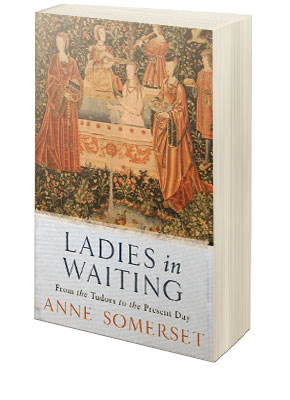From the Tudors to the Present Day
Weidenfeld & Nicolson; Alfred A Knopf, 1984; Phoenix Press 2002 and 2005
For centuries, the most beautiful, able and aristocratic women in England competed for positions at court. Some who came to serve were remarkable for their learning and exemplary virtue, but others were notable for promiscuity and lack of scruple. The role of lady-in-waiting was perhaps the only occupation that a talented and ambitious upper-class woman could pursue with an appearance of propriety, but in many reigns there were ladies who combined a career at court with pursuit of the oldest profession of all.
Some ladies were drawn to court by a lust for money and power. In the reign of the much-married Henry VIII, it was even possible for a lady-in-waiting to progress to becoming queen, although, as more than one found out to her cost, crowned heads could roll. Confidantes of subsequent monarchs exploited their closeness to the throne by wielding political influence. Lucy, Countess of Carlisle, Lady of the Bedchamber to King Charles I’s French wife, Henrietta Maria, was for a time the Queen’s most trusted adviser, but ultimately betrayed her to her enemies in Parliament. Fifty years later Queen Anne’s Mistress of the Robes and one-time intimate friend Sarah Duchess of Marlborough lost the Queen’s affection when she sought to impose her political will on the sovereign, and she found herself superseded when the Queen became attached instead to another, more junior female attendant. As late as the reign of Queen Victoria, politicians were disquieted by the way Victoria employed her ladies to convey her wishes and flout ministerial authority in a manner hardly compatible with constitutional monarchy.
Several ladies-in-waiting became royal mistresses, showing few qualms about betraying the queen consorts they ostensibly served. In the reign of Charles II, the rapacious Lady Castlemaine shamelessly amassed a fortune and flaunted her hold over the King; rather less fortunate was the downtrodden Countess of Suffolk, long serving mistress of George II, who was constantly humiliated by both her lover and his wife. If bedding the King was not an option open to all, many ladies came to court in hope of finding husbands, only to succumb to constant assaults on their virtue or to find themselves denied permission by their sovereign to marry.
Drawing on an enormous variety of sources, Anne Somerset provides an illuminating guide to the character, profligate or pious, of each court. In chronicling the life of famous and infamous ladies who served royalty in the past, she casts light from a fresh, intimate angle on four hundred years of monarchy. Contained within the stories of the individual women is a consistently entertaining commentary on the manners, morals and shifting mentality of the royal, the rich, and the prominent throughout the centuries, resulting in social history at its most enjoyable and vibrant.
‘Extraordinarily enjoyable... Colourful and entertaining...A Naughty Knickers version of our island story’. Auberon Waugh, Daily Mail
‘A pleasing account of the upper-class ladies who slaved, suffered and starved in royal service’. Sunday Times
‘An extremely informative and well-documented study that... because it is full of odd episodes and graphic portraits, will make admirable bedside reading’. Sunday Telegraph
‘Lady Anne writes with perception, wit, candour and a confident authority’. Hugh Montgomery Massingberd, The Spectator
‘Well-written, well-researched and well-produced’. Books and Bookmen
‘From four centuries of courtly life and love, Anne Somerset has compiled a sparkling history, lucidly written and of impeccable scholarship’. Country Life
‘This delightful history of the distaff royal household is a perfect English set piece....This author has earned a lifetime post as a Lady of the Pen who can evoke the whisper of ruffled skirts on stone stairs and legendary candlelit faces through mullioned windows’. Florence King, Philadelphia Inquirer

